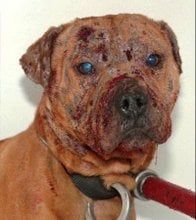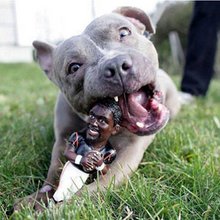Dangerous Dogs: Beating a Bad Rap

Anyone that’s ever rented an apartment knows about the pet clause. There are breeds that many leasing offices won’t tolerate. These so called “dangerous dogs” are blacklisted and treated a little more like animals than usual. However, this overarching reactionary attitude begs the question: is this kind of puppy profiling helpful in preventing dog bites? Does an animal’s bad attitude spring from the womb, or is does theproblem lie elsewhere? Is the label, “dangerous breed” an arbitrary and inaccurate term?
German Shepherds, Doberman Pinchers, Pit Bulls, Rottweiler, Huskies, and Chow Chows have all at one time or another been lambasted as aggressive or dangerous dogs. This is due to a study performed by theCDC that recorded dog-related deaths between 1979 and 1988. These animals were near the top of the list. But the list didn’t properly reflect the rare nature of dog attacks. Pit bulls were rated the most dangerous dog with 66 deaths. That’s less death in a decade than can be attributed to bee stings in a single year.
If certain breeds really are more vicious then why do so many people love and adore their particular dogs? Dogs that never show their teeth to anybody, not even the mailman. Luckily, insurance companies applied common sense to the situation and started keeping dangerous dog registries, rather than blanket dangerous breed labeling. Despite these advances in the battle against doggy discrimination there are still pockets of resistance against greater understanding of the complex relationship dynamics between people and canines.

The state of Ohio labels Pit bulls as dangerous dogs, and requires a whole slew of state ordinances for bull owners to abide by. Now to be fair to the legislature, Pit bulls have long been bred for aggression. A “game” pit bull is a particularly prized possession for certain seedier denizens of back alleys. Generations of this sort of breeding have taken place for the sole purpose of creating fighting dogs. Whereas thousands of years of domestication moved dogs toward docility and sociability, it’s only taken several generations to turn Pit bulls into some savage competitors.
Despite the terrible mistreatment many of these “dangerous dogs” must endure, they are still extremely amiable companions to a properly educated human. They’ve been trained and bred to fight other dogs, and usually don’t make for the best pets in homes with multiple animals or children, but to their adult owners they are fiercely loyal. It takes a strong hand and a cool  head to handle one of these rescued fighters, but it just goes to show that no amount of mistreatment is as powerful as kindness.
head to handle one of these rescued fighters, but it just goes to show that no amount of mistreatment is as powerful as kindness.
With even the most terrible treatment, no dog is beyond salvage. This makes the pit bull its own greatest advocate. If a dog bred over several generations for fierce aggression and unbridled savagery can, within its own lifetime, become a loving companion, it proves that every animal needs to be dealt with on an individual basis. Even a dangerous dog can beat a bad rap through the simple application of love.
German Shepherds, Doberman Pinchers, Pit Bulls, Rottweiler, Huskies, and Chow Chows have all at one time or another been lambasted as aggressive or dangerous dogs. This is due to a study performed by the
If certain breeds really are more vicious then why do so many people love and adore their particular dogs? Dogs that never show their teeth to anybody, not even the mailman. Luckily, insurance companies applied common sense to the situation and started keeping dangerous dog registries, rather than blanket dangerous breed labeling. Despite these advances in the battle against doggy discrimination there are still pockets of resistance against greater understanding of the complex relationship dynamics between people and canines.

The state of Ohio labels Pit bulls as dangerous dogs, and requires a whole slew of state ordinances for bull owners to abide by. Now to be fair to the legislature, Pit bulls have long been bred for aggression. A “game” pit bull is a particularly prized possession for certain seedier denizens of back alleys. Generations of this sort of breeding have taken place for the sole purpose of creating fighting dogs. Whereas thousands of years of domestication moved dogs toward docility and sociability, it’s only taken several generations to turn Pit bulls into some savage competitors.
 head to handle one of these rescued fighters, but it just goes to show that no amount of mistreatment is as powerful as kindness.
head to handle one of these rescued fighters, but it just goes to show that no amount of mistreatment is as powerful as kindness.With even the most terrible treatment, no dog is beyond salvage. This makes the pit bull its own greatest advocate. If a dog bred over several generations for fierce aggression and unbridled savagery can, within its own lifetime, become a loving companion, it proves that every animal needs to be dealt with on an individual basis. Even a dangerous dog can beat a bad rap through the simple application of love.





 すべての投稿
すべての投稿 ヒントとテクニック
ヒントとテクニック 健康・QOL
健康・QOL 商品レビュー
商品レビュー 愉快な話題
愉快な話題